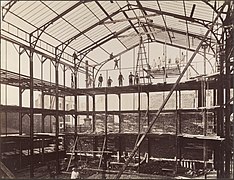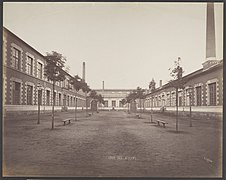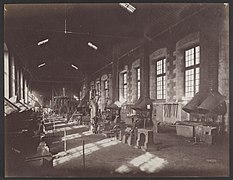Louis Lafon

Louis Lafon was a French photographer active between the 1870s and 1890s.[1] He is noted for having photographed industrial scenes as well as landscapes involving man-made artifacts.[2]
Work[edit]
The Metropolitan Museum of Art has written about Lafon, “He was based in Paris, photographed primarily industrial subjects, and won a medal for his submissions to the 1874 exhibition of the Société Française de Photographie.”[3]
Lafon used the albumen print technique which produces a glossy surface on the images.[4]
Lafon created a large scale (by 19th c. standards) photograph (now in the collection of Princeton University Library) of a high-speed printing press fabricated by Hippolyte Marinoni (Presse Universelle). The press revolutionized the mechanical reproduction industry.[3]
Collections[edit]
Lafon's work is included in the collection of the Metropolitan Museum of Art,[5] the National Gallery of Art, Washington,[6] the Clark Art Institute,[7] and the Museum of Fine Arts Houston.[1]
Gallery[edit]
-
Construction Site, 1880s
-
Factory Interior, 1880.
-
Cour des Ateliers
-
Forges, circa 1880.
-
Lessart viaduct on the Rance river. October 1879.
-
The Foundry
-
Railroad Viaduct at La Fontaine-des-Eaux, France. C. 1879-1880
References[edit]
- ^ a b "Louis Lafon: [Railroad Bridge In Landscape]". emuseum.mfah.org.
- ^ "Graphic Arts: Acquisitions Archives". www.princeton.edu.
- ^ a b Melby, Julie. "Louis Lafon". Princeton University. Retrieved 27 August 2021.
- ^ "A City Transformed". Clark Art Institute. Retrieved 27 December 2021.
- ^ "Tubular Jetty, Mouth of the Adour, Port of Bayonne". www.metmuseum.org.
- ^ "La Fonderie (The Foundry), 1880s". www.nga.gov.
- ^ "Louis Lafon (French), 1870s–1890s Fittings (Ajustage) C. 1880". The Clark Art Institute. Retrieved 27 August 2021.







